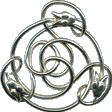Naalbinding
The craft of naalbinding was practised by Romans, early Egyptians and people in various Scandinavian and Eastern European countries. It is also known as single-needle knitting, but it is topologically distinct from knitting or crochet as it is a knotted, rather than a looped technique. The worker uses a short length of wool threaded through a broad needle to create fabric by sewing. naalbinding stitches may be considered to be variants on blanket stitch. A nalbound garment will not run if damaged.
Naalbinding was most commonly used to make socks but it's also great for hats and mittens. Really enthusiastic practitioners make larger garments such as shawls or scarves or even dresses!
People in England don't much seem to have gone in for naalbinding: my guess is that foot-coverings were made of sewn cloth or dried grasses until the introduction of knitting. The Jorvik sock was made in the 10th century and found in York. Its simple stitch, unknown in Scandianavia, makes me think that it was made by a local who saw the more sophisticated socks worn by Viking incomers.
It's not easy to buy pure wool nowadays so I was very pleased recently to meet a man who sells his pure Shetland wool by mail order. It comes in a range of natural colours and is ideal for knitting or naalbinding.
Sock Construction illustrates all the ways I know of turning the heel of a naalbinding sock. Most people learn naalbinding because they want to make authentic Viking socks, and heels are always their, erm, Achilles' heel, but it's not that hard and there are lots of ways of doing it. his article includes one method I haven't mastered, and one I haven't even tried yet!
